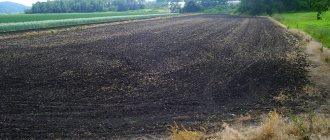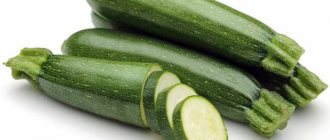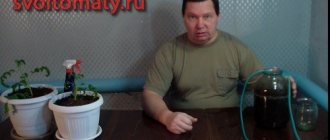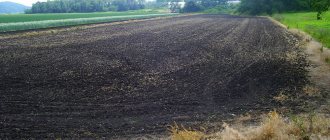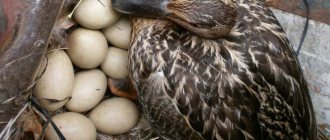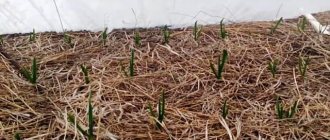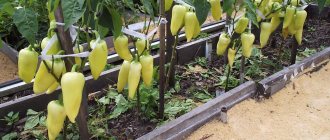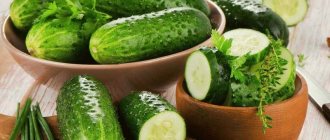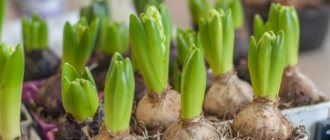Humus (humus or, as it is also called, rotted/decayed manure) is the last stage of the cycle of organic substances in nature.
After all, only it fills the soil with humates, which are the only nutrition compatible with plant roots.
High-quality humus contains all the substances necessary for the development and fruiting of plants, therefore, without reducing productivity, it can replace the vast majority of modern organic and mineral fertilizers.
In this article we will talk about:
- what is humus, what kind of manure is considered rotted, and how to distinguish it from fresh;
- how long does it take for manure or droppings to rot, and how to make humus quickly and efficiently;
- how to use humus in the garden in spring and autumn, and when is the best time to use last year's manure.
What is humus?
Humus is any plant organic matter that has been completely processed by humus-forming microorganisms , which include some types of bacteria and fungi, and the process of rotting is also called humification.
This process, in addition, is the last link in the carbon cycle in the plant world, because both humic acids and cellulose are derivatives of carbon, because it is the main building material for all plant cells.
We have already talked about how bacteria feed on organic matter from manure and, after numerous transformations, produce humates, so we recommend that you read this article carefully.
In appearance, humus resembles loose, slightly moist soil of dark colors and smells like earth.
A completely rotted pile of manure will not have any mucus or unpleasant odor, even if you dig hard at it.
If you take humus in your hand, there will be no unpleasant sensations, because in its structure and looseness it is very similar to black soil.
Errors in preparing humus and useful tips
Oak leaves take longer to rot than fruit tree leaves.
When producing humus yourself, it is important to avoid two mistakes:
- Adding dry mass. If there is insufficient moisture, decomposition will proceed very slowly. If the mass dries out over time, you need to water it with water or slurry. Overmoistening is also undesirable. The optimal humidity should be such that when compressed the mass sticks together, but does not flow.
- Planting of infested weeds. Seeds take longer to rot than the vegetative mass. To avoid bringing them into the garden beds in the future, only grass without seeds should be allowed into the humus.
Many gardeners do not have the patience to wait for the biomass to completely decompose. Therefore, both manure and plant litter are often used in a semi-rotted state. To speed up the humification of raw materials, it is advisable to water them not just with water, but with solutions of EM preparations:
“In one season I get excellent humus from horse manure by watering the pile with Baikal EM-1 solution. A half-liter bottle is enough for 1 ton of manure. The main thing is to spill it after the organic matter stops burning, otherwise the bacteria will die and there will be no use” (Denis, Orenburg).
In addition to the drug “Baikal EM-1”, “Shine-3” is suitable for these purposes → application. It can be used in dry form, sprinkling the powder over layers of organic matter. Find out → application of Baikal EM-1, how to breed + reviews
Differences from compost, sapropel and vermicompost
All these substances appear as a result of the processing of the substrate, that is, the waste of animals or birds, as well as various plant residues and waste by humus-producing living beings.
Therefore, we prepared a table in which we included :
- all these substances, with the exception of humus;
- the time required to convert organic matter into a finished product, taking into account various acceleration methods;
- a brief description of the advantages and disadvantages of each product.
| Product | Time for complete transformation of organic matter into a finished product | Brief description, as well as advantages and disadvantages compared to humus |
| Compost (a rotted mixture of manure or droppings with plant remains and kitchen scraps) | 1–3 months hot method; 3–8 months with treatment with bacterial preparations; 1.5–3 years without acceleration | After complete rotting, it is similar to humus, but contains more microelements and better loosens the soil. |
| Sapropel (bottom silt) | 7–15 days in thermophilic mode; 20–50 days in mesophilic; 60–150 days in psychrophilic | Contains fewer microelements and also very weakly loosens the soil |
| Biohumus (vermicompost) | 10–15 days, cannot be expedited | In terms of the ratio of humates and microelements, as well as the effect on the soil, it is completely identical to humus, however, worms are very demanding on the quality of the starting material and living conditions |
How to obtain humus from the excrement of cattle, pigs, and chicken droppings?
Regardless of the type of animal or bird from which the excrement is obtained, when making humus or compost from it in any type of manure or droppings, be it horse manure, cattle manure, pigs, chicken manure or any other, the same processes occur.
After all, rotting is a consequence of the multi-stage action of bacteria , which, with the help of enzymes, convert any organic matter into humic substances (humates).
Therefore, it is not the breed of birds or animals that is more significant, but the amount of their excrement and the method of turning it into humus.
There are 2 ways by which you can obtain both humus and compost:
- traditional;
- fast, he's hot.
Traditional way
Manure or droppings are taken to a puss site, that is, an earthen area intended for storing these materials, and dumped there in a heap (hill), after which it is left for several years.
To improve the quality of humus, the pile is slightly moistened and sprinkled with ash or lime, which slightly reduces the acidity.
Then the collar is covered with tarpaulin or polyethylene, leaving a small space below for ventilation, because during the life of the bacteria they will release various gases, including ammonia and methane. In addition, the covering material reduces moisture loss due to evaporation, so bacteria will not lack water.
When choosing a place for pus, you need to consider several important factors . The further it is located from the place where birds or animals are kept, the higher the costs of transporting excrement; the further the pus is located from the place where the humus is used, the higher the costs of its delivery.
In addition, in the Russian Federation there are regulatory documents that strictly regulate the storage of manure or droppings.
These are the documents:
- GOST 26074-84 (ST SEV 2705-80) Liquid manure. Veterinary and sanitary requirements for processing, storage, transportation and use;
- Veterinary and sanitary rules for the preparation of manure, droppings and waste for use as organic fertilizers for infectious and invasive diseases of animals and poultry;
- Hygienic requirements for livestock facilities SanPin 2.2.3. — 09.
Neglecting the requirements of these documents can lead to such unpleasant consequences as:
- outbreak of infectious diseases among animals, birds, people;
- litigation related to violations of the rights of people living nearby;
- large fines.
The period of complete rotting of excrement with this method of obtaining humus is 2–5 years and depends on the temperature and humidity of the air.
The higher the average annual temperature and humidity, the faster bacteria can process all the material.
Therefore, in cold regions this method is not popular , because it is necessary not only to wait many years for the decay process to complete, but also to find new places for rot every year, or even several times a year.
Considering the strict requirements for humus, as well as the negative impact of this process on the soil, it is not so easy to find many convenient places, so in cold regions it is easier to obtain humus in other ways.
Fast or hot
Bacteria that process organic matter and produce humus release thermal energy and are also highly dependent on ambient temperature. By reducing heat loss, it is easier for bacteria to heat the substrate and transition to a higher temperature regime.
To reduce heat loss, insulated containers of various shapes are used. The most popular are wooden boxes and holes dug in the ground, the walls of which are insulated with dry vegetation or other materials.
The optimal dimensions of a pit or box are 2x2x1 m (length, width, depth). This is because a smaller box will hold too little substrate, and increasing the size will make it more difficult to stir the contents.
Moreover, it is necessary to stir 1–3 times a month , the more often, the faster the process of decay will occur, because bacteria cannot immediately saturate the entire volume of the substrate, so they first process those fragments that are located next to them.
Mixing the substrate makes it easier for bacteria to access those fragments of the contents of the box or pit that were previously separated from them by partially processed manure or droppings.
If there is no dry grass or dung, then insulate the walls of the box or pit using polystyrene foam, in which you need to make several small holes to remove gases.
The rotting time of the substrate in a box with insulated walls and a lid is 4-6 months, in a pit with insulated walls and a lid - 8-12 months.
One option for the hot method is to use manure or droppings to heat greenhouses and hotbeds, which we talked about in this article. The only disadvantage of this method is that before extracting the finished humus, you will have to remove the fertile and separating layers of soil from the bed.
Method for preparing herbal and leaf humus
To obtain manure humus on the site, it is necessary to allocate a special place.
Herbal and leaf humus is prepared quickly and does not require much space or labor. You can lay raw materials for rotting from early spring to late autumn. To do this you will need thick plastic bags:
- mown grass or fallen leaves are compacted tightly into bags;
- if the mass is dry, it is slightly moistened with water;
- the bags are tied;
- Using an awl or a nail, several ventilation holes are made in the bags;
- the bags are put away in the shade.
It is convenient to prepare humus in bags because it results in almost “conveyor” production. There is no need to wait long for a huge pile of raw materials to decompose - small volumes of fertilizer for seasonal feeding will always be at hand.
After a year, the plant humus is usually ready. The rate of decomposition in this case depends on the air temperature. If the bags stand outside in winter and freeze, the humus will turn out a little later - after 1.5 years. If you put them in the basement for the winter, where the temperature does not drop below 00C, the fertilizer can be ready by next summer.
How to make a compost bin?
The easiest way is to use a suitable sized wooden plywood box from some large-sized equipment for this purpose; in most cases, such boxes are lined with thick plywood and have sufficient strength.
If there is no such container, then you can make a box from a sawn board 25 mm thick and plywood of a suitable thickness (for walls 5–7 mm, for floors and lids 10–15 mm). The outer body (frame) is assembled from the boards, which is then sheathed from the inside with plywood, joining it only on the boards.
If there is no plywood, then the box can be made from boards alone, but in this case the outer body and bottom are made from ordinary boards, and the walls are lined with boards 15–20 mm thick.
Regardless of the sheathing material, the outer frame is reinforced with metal corners or tape so that the substrate does not squeeze the walls out. It is not necessary to place the sheathing strips close to each other, but the distance between them should be 1–5 cm; the smaller it is, the easier it is to deal with spillage of the substrate, and the larger it is, the fewer boards will be required for its manufacture.
Boxes with a large gap between the cladding boards should be lined with mounting mesh, which is used when plastering surfaces that have low adhesion to cement mortars.
The mesh is secured using a stapler or small nails. If the box is lined with plywood or boards laid closely, then ventilation holes with a diameter of 1–3 cm are drilled in the walls and bottom, located in increments of 20–40 cm.
In cold regions, as well as where it is impossible to insulate the box with dry grass from the inside, it is lined with foam plastic on the outside, sealing most of the cracks and leaving only small gaps at the bottom and top for gases to escape.
How to speed up cooking?
To speed up decay with the substrate, perform the following actions:
- stir;
- treated with bacterial preparations;
- add chopped fresh or dry vegetation (compost);
- insulate the collar;
- introduce worms.
Tedding
The peculiarity of humus-forming bacteria is that they cannot process large fragments of manure or droppings, because to do this they have to move very slowly inside such a fragment, which is why the processing speed drops tenfold.
Tedding helps to cope with this problem and makes it easier for bacteria to access the contents of solid fragments , which are destroyed during tedding.
In addition, the greatest activity and mobility of bacteria is observed only in a liquid medium, therefore, in a heap of substrate, microorganisms very slowly colonize new territories, and tedding distributes bacteria to previously inaccessible areas. The choice of tedding tools depends on the size of the pile or box, as well as financial and technical capabilities.
For servicing the box, ordinary garden forks are best suited , with the help of which the contents of the box are carefully dug up, trying to reach the bottom.
It is not advisable to use a shovel for this, because it separates and turns over the layer of substrate, but does not loosen it.
If there are no forks, then you can use a strong wooden block or an iron pipe of small diameter, and the length of any of these tools should be at least three times the depth of the box, and the thickness should not exceed 5 cm.
These tools are stuck in increments of 10–15 cm into the rotting mass to the bottom, and then, leaning on the side of the box, they press on the second edge of the bar or pipe and draw the buried edge through all layers of the substrate to the very top. This method is also suitable for turning the substrate in a hole.
Small piles can also be turned with a fork or a metal pipe, but for large piles a tractor-mounted turner is best suited . You can find the most popular models and descriptions of these devices by following the link.
The turners turn over and crush the contents of the pile, thanks to which bacteria gain access to fresh material, which means that the process of rotting is accelerated and the likelihood of the appearance of pathogenic microorganisms that can spoil the humus is reduced.
Another reason why tedding accelerates rotting is due to the fact that some of the substances that bacteria secrete are toxic to them, which is why the accumulation of these substances leads to the death of part of the bacterial colony and slows down their work.
These substances include ammonia, methane and some other gases. After turning, the ability of the substrate to pass gases increases , due to which their concentration inside the rotting mass decreases.
Treatment with bacterial preparations
The bacteria content in fresh manure or droppings is not enough for rapid decay, so under natural conditions the process takes several years.
When there is a need to accelerate decay, and tedding and insulation are not applicable for any reason, increase the number of bacteria by introducing bacterial preparations .
Before using the drug, it is advisable to prick the surface of the substrate with a pitchfork, due to which many deep holes will appear in it, through which the drug will penetrate into the heap, which means that the bacteria will cover a noticeably larger area of manure or droppings than with simple watering.
When choosing a drug, it is necessary to consider what bacteria are in it. After all, drugs can be either aerobic, that is, containing microorganisms that require oxygen, or anaerobic, that is, not requiring oxygen.
In addition, it is necessary to take into account the optimal temperature for the bacteria contained in the preparation , because microorganisms of one temperature regime reproduce poorly and quickly die in any other temperature regime.
Therefore, mesophilic microorganisms are best suited for processing uninsulated piles or the contents of poorly insulated boxes (optimum temperature 30–45 degrees). And for those who are well insulated - thermophilic (optimal temperature 50–60 degrees).
If you have to obtain humus in cold regions, then it is better to use preparations containing psychrophilic bacteria, that is, they normally live at temperatures of 10–20 degrees above zero.
However, even in cases where the temperature conditions of the bacteria and the substrate do not coincide, treating the substrate with the drug will provide many benefits , because in addition to bacteria, it also contains enzymes that break down organic matter into substances suitable for feeding microorganisms.
Composting
Compost is a mixture of manure or litter with any plant debris, and the process of rotting it is called composting.
The main difference between a substrate made from manure and litter from compost is that compost contains cellulose, lignin and other complex saccharides , which make the finished humus more balanced.
It takes several years for complete rotting of excrement, and several months for complete rotting of chopped vegetation, so adding chopped vegetation to manure or litter will, albeit slightly, speed up decay.
After all, crushed remains of vegetation, not treated with enzymes, make it easier for bacteria to colonize “new territories” than with much denser excrement, often consisting of compacted pieces.
In addition, the porous structure of vegetation facilitates the release of toxic gases , due to which their concentration is reduced, which means that bacteria live and work in more favorable conditions, which also speeds up the process of decay.
However, you should not add vegetation that is affected by pests or diseases to compost, because the enzymes secreted by bacteria are not always fatal to microbes that cause diseases of the green mass and the pests that feed on it.
If infected vegetation gets into the substrate, then there is a high probability that pathogens or pest larvae will survive and in the spring, when green mass appears, they will begin to actively reproduce on it. If this happens, it will be very difficult to prevent mass plant disease or pest invasion.
There are no optimal sizes of chopped vegetation; however, we recommend not adding fragments longer than 10 cm to the substrate .
After all, even after rotting, they retain their structure and some strength, so they will interfere with collecting humus with a shovel.
However, this limitation does not apply to composting sites and piles that are turned using attachments, because turners not only loosen and mix the material, but also effectively crush vegetation.
You can add not only freshly cut or picked green mass to the compost , but it is advisable to soak the latter before use, this will create the most favorable conditions for bacteria, the activity of which increases in proportion to the humidity of the substrate.
Another advantage of composting is that it slightly increases the acidity of the humus, making it slightly acidic rather than neutral.
This material is ideal for plants that love an acidic environment , but if the acidity is higher than required, then it can always be reduced using:
- ash;
- lime;
- dolomite flour;
- chalk.
It should be noted that, as in the case of humus, composting, for example, cattle manure is no different from preparing compost from bird droppings.
Insulation of the collar
If it is impossible to use a quick method of rotting due to too large a volume of manure or droppings, and humus must be obtained next year, then the process of rotting can be accelerated by insulating the pile .
To do this, the pile is thickly covered with thin soft branches or thick plant stems on top of a tarpaulin or film, then covered with earth.
It turns out to be an analogue of rapid rotting in a pit, where the role of walls is played by sprinkling of soil. In warm regions, the thickness of the coating can be 10–15 cm, in cold regions 50–80 cm.
Complete rotting of the substrate in an insulated pile takes 10–15 months . This takes a little longer than in an insulated pit, and is due to the fact that such a pile is very difficult to turn, because first you need to remove the soil and branches, and after turning, put everything back in place.
However, to speed up the processing of large volumes of manure or litter, this method is better than frequent tedding, because it seriously reduces labor costs and also allows you to use a smaller area.
Infestation of worms
Earthworms (aka dung) worms, together with bacteria, are involved in the processing of organic matter and the process of soil regeneration, so adding them to the substrate will not only improve the quality of the finished humus, but will also speed up its rotting.
Moreover, the effectiveness of worms depends on the comfort of living conditions and the speed of their reproduction.
The widely advertised “California” and “Prospector” breeds reproduce 2–4 times faster than ordinary worms, but are extremely demanding on temperature and quality of the substrate, so they are not used when processing large volumes of manure or droppings.
After all, this can only be done outdoors, which means that the worms will constantly experience stress due to daily and seasonal temperature changes.
Therefore, it will be more effective to introduce ordinary garden worms , although they reproduce noticeably more slowly, but they can easily tolerate temperature fluctuations and the lack of green mass in the substrate.
However, any worms cannot be added to a substrate that rots at high temperatures, because heating the medium to a temperature of 25–30 degrees leads to their death.
Therefore, worms are used only to accelerate decay in the traditional way or placed in boxes and pits used in cold regions.
How long does it take for the material to rot?
It is impossible to say exactly how long it takes for chicken droppings, horse manure or the excrement of any other animals and birds to rot, and how quickly it can be turned into full-fledged humus.
The rate of decay depends on factors such as:
- rotting method;
- type of substrate;
- temperature inside the substrate;
- measures taken to speed up the process.
To rot in the traditional way, it is enough to take the entire substrate to a site intended for its storage, which can be used as a section of the field remote from residential premises, and pile it there.
To turn manure into humus quickly, you will need a hole in the ground or a wooden box of suitable volume. To reduce heat loss, the walls of the box or pit are insulated using natural or artificial materials.
If it is necessary to speed up the process, the substrate is treated with bacterial preparations that contain strains of the necessary bacteria, as well as enzymes that break down organic matter and convert it into substances suitable for feeding bacteria.
When the collected manure or litter is too much to rot quickly, but it is not possible to wait several years, the pile is treated with drugs and insulated with branches and soil .
In order to turn manure into humus as quickly as possible, a measure such as tedding is added to all of the above methods.
It improves the removal of gases toxic to bacteria, and also mixes the substrate, distributing bacteria and their enzymes more evenly.
We have compiled a table in which we included both methods of decomposition and all possible ways to speed up this process, as well as the average time required to turn manure or droppings into humus.
| A method for accelerating the decay process | Rotting method | ||
| Traditional (in piles) | In a wooden box | In the hole | |
| No acceleration | 2–4 years | 6–10 months | 10–15 months |
| Insulation | 1–2 years | 5–7 months | 8–12 months |
| Treatment with bacterial preparations | 10–15 months | 4–6 months | 7–10 months |
| Tedding | 1–2 years | 5–7 months | 8–12 months |
| Composting | 10–18 months | 2–3 months | 5–7 months |
| Composting, insulation, treatment with bacterial preparations and regular tedding | 6–10 months | 2–3 months | 5–7 months |
| Infestation of worms | 10–20 months | 5–7 months | 7–10 months |
| Composting and worming | 8–15 months | 4–6 months | 6–8 months |
What does it look like when finished, and how to distinguish it from fresh or not completely rotten?
The finished, completely rotted material looks like loose black or dark brown soil.
It is soft and crumbly to the touch; if you take it in your hand, you will not feel any unpleasant sensations, as if you were picking up freshly plowed or dug up soil.
Ready humus emits a persistent earthy smell . Manure or droppings cannot be considered completely rotted if there is: outside or inside the substrate:
- barely noticeable odor of manure or droppings;
- swamp smell;
- slime.
Features of autumn and spring application of humus
In the spring, immediately before planting, completely rotted compost or manure is added. It is advisable to add one- or two-year-old humus into the holes; it will not harm the formation of the root system. If you use fresh cow manure, then in the future you will have to clean the area from a large amount of weeds. Therefore, before using it, it is necessary to let it lie in the ground for 21 days.
In the fall, adding humus helps the soil recover faster, improve its structure and reduce the number of weeds. Autumn treatment destroys pathogenic microbes that cause diseases of green spaces. It simplifies soil fertilization. At this time of year the beds are empty, so there is no danger in applying fresh fertilizer.
Can last year's excrement be considered rotten?
Under natural conditions, manure and droppings rot over several years, but thanks to various methods of accelerating this process, completely rotted humus can be obtained in a few months.
Therefore, it is necessary to evaluate the material not by its shelf life, but by its condition .
To assess the condition of the material, you must do the following:
- Carefully inspect the pile from all sides; if there is mucus on it or its color does not fall within the range from dark brown to black, or some areas are very different in brightness or shade, then most likely the process of rotting has not yet been completed.
- Being close to the heap, sniff, if there is even a slight smell of excrement, swamp or mud, then the process of rotting has not yet been completed.
- Using any suitable tool, dig the pile in several places to the very bottom and pull out some material from the middle of the pile. If it has an unpleasant odor, is covered with mucus, or its color differs from the color of the surface, then the material is not ready yet - it is still heavily stale manure.
Is it possible to spoil it?
The excrement of animals or birds is food for many microorganisms, and the metabolism of many of them is not compatible with the metabolism of plants, which means that as a result of their vital activity, substances other than humus will be obtained.
Most of these microorganisms slightly deteriorate the quality of humus, but cannot spoil it, that is, make it unsuitable for use. The exception is mold fungi, which actively multiply where manure or droppings are improperly stored.
The most common causes of mold are poor ventilation of the substrate at high humidity and frequent condensation on the inner surface of the covering material.
To prevent the appearance of mold, you need to stir the substrate at least once a month, make a lot of ventilation holes and properly insulate the box, hole or pile. Humus with mold can be used as mulch and even fertilizer, filling fields with it, but it is not suitable for soil mixture or filling into holes before planting seedlings.
How humus is used as fertilizer
In the spring, fertilizing from humus is applied to the holes and furrows before planting seeds and seedlings ; you can also feed the soil of vegetables planted in the fall (garlic, carrots, onions). A large percentage of this fertilizer is applied to boxes or greenhouses where seedlings are planted as a mulching agent and fertilizing for planted seedlings.
It is better to apply humus for trees, bushes and potatoes in the fall , but for vegetable crops, on the contrary, it must be applied before digging , that is, in the spring.
If the manure humus is not rotten enough, then large parts of the manure can be soaked in a container with water (1:1), let it brew for a week and water the bushes with the prepared solution as if it were a liquid fertilizer (watering carefully, pouring at the roots is not recommended).
You can apply manure in the fall, scatter it under the snow, but after the snow melts, a large number of weeds appear that will need to be removed and weeded to prevent them from overgrowing.
Work with manure is carried out with gloves.
To prepare organic fertilizer from manure, it is necessary to level the heap until it becomes loose and leave for 5-7 days to “ferment”; then the heap with manure is covered with earth up to 10 cm and covered with film (to maintain high nutritional value). In spring, the soil is removed and the film is left.
To prepare humus from manure, it is left under a film for the entire winter period, sprinkled with earth.
Worms and larvae
When a pile of manure or droppings lies on fertile soil, various worms penetrate from it into the pile, which, like bacteria, feed on organic matter.
If you find worms in manure, as well as in almost finished humus, you should not be alarmed; on the contrary, such humus will be more balanced for plants than that obtained without the participation of these organisms.
After all, earthworms (they are often called dung worms) are the same participants in the organic cycle as bacteria, but they process organic matter according to a different principle, resulting in vermicompost containing humates and effectively complementing humus.
The situation is the same with various larvae, with the exception of mole crickets, which pose a serious threat to vegetation.
Mole cricket larvae look pretty
To avoid their appearance in the finished humus, it is necessary to carefully examine the substrate during each turning and remove any detected pests from it. In addition, they do not survive hot processing of manure or droppings.
Mistakes made by gardeners
For better rotting, the compost heap should be turned and turned over from time to time. Without moisture, the fermentation process is very slow. If it’s hot summer, the pile is watered, otherwise the contents will dry out and humus won’t work. Humidity should be 50-60%.
Tips to avoid mistakes:
- We must not forget to make a drain for water accumulation, otherwise the compost heap will rot.
- If you add only carbohydrate or only nitrogen components, you will end up with low-quality humus.
- To obtain fertilizer for 12 months, you cannot use large roots, especially from strawberries.
- The layer of manure for humus should be 35 cm high if fertilizer is used in the spring, and 50 cm if fertilizing is done in the fall.
- You cannot put weeds with seeds in the grass humus, which can germinate and clog the area. 1 kg of manure can contain more than 5,000 seeds.
- To prevent rain from washing away useful substances, the manure heap must be covered with a lid or polyethylene.
- It is forbidden to water plants at the roots with liquid humus.
- Earthworms should be introduced into manure and compost heaps; they will speed up the maturation of the compost.
- The walls of the compost bin should have gaps to provide ventilation for fermentation.
- Humus for mulching should be dark and loose.
- To speed up the fermentation process, bacterial agents are used: Baikal, Economy Harvest.
- Work with manure is carried out with rubber gloves.
Methods of application
To use humus correctly, you need to understand what it is and how it affects plants or soil.
The basis of humus is humic substances (derivatives of humic acids), which are the only food available for absorption by plant roots.
Also, any rotted manure, including horse, cattle, etc., contains various microelements and components that improve the structure of the soil .
Therefore, completely rotted manure or droppings affect the soil and plants as follows:
- fill the soil with nutrients, thanks to which plants develop much faster;
- fill the soil with microelements necessary for plants to form structure and proper metabolism;
- improve the structure of the soil, making it looser, which improves the soil’s ability to conduct water.
How to use in spring?
In spring, ready-made humus is used for various purposes .
Among them:
- production of soil mixture;
- fertilizing holes before planting seedlings;
- application under already planted or perennial plants;
- mulching the soil.
Making soil mixture
If the site has depleted or not very rich soil, which for any reason could not be fertilized in the fall, then it is better to use a soil mixture to germinate seeds and produce seedlings . To obtain it, humus and garden or vegetable soil are mixed in equal parts.
If the soil is clayey, then add 5–10% of the total mass of the mixture of clean river sand. In addition, it is necessary to measure the acidity of the resulting mixture using a garden pH meter.
If the soil mixture is more acidic than necessary for the selected plants, then add a little ash or other substances used to reduce acidity and mix thoroughly, after which the pH value is measured again.
If the acidity is lower than required for the selected plant, then rotted pine needles or humus from sawdust should be added to the soil mixture.
Often, owners of plots where the soil is more alkaline than necessary for the selected plants add sawdust, pine needles and chopped green mass to the substrate , because they increase the acidity of the finished humus.
Fertilizing holes before planting seedlings
This technique allows plants to develop a root system faster, so they can receive more nutrients by pulling them from a wider area.
To do this, the depth of the trench is increased by 10–20 cm, then a layer of humus of the same thickness is poured onto the bottom.
To increase the effect, the hole is filled not with soil, but with a soil mixture , thanks to which the plants will develop effectively even on soils that are depleted or have not been fertilized since the fall. If the acidity of the fertilizer or soil mixture is lower than necessary, then a thin layer of crushed green mass is placed at the bottom of the hole or trench; if it is higher, chalk or other substances are added.
Application under already planted plants
To fertilize already planted plants, including perennials, humus is poured in a mound around the trunk. The height of the slide is limited only by the level of the lower foliage, the minimum distance to which is 5 cm. The width of the slide is not limited in any way and depends only on the degree of depletion of the soil and the amount of available fertilizer.
On rich but unfertilized soil, it is enough to proceed from the norm of one bucket for every square meter of area. On severely depleted soils that cannot be fertilized in any other way, the rate must be increased by 5–10 times.
In addition, after adding humus, it is advisable to dig up the soil and water it so that the nutrients quickly reach the roots of the plants.
If it is impossible to dig up the soil, then it is loosened to a depth 2–3 times greater than the height of the hill, but the level of the roots is also taken into account. In cases where some of the roots lie close to the surface, loosening or digging is avoided. Then the plant is watered abundantly with water at the rate of 2-3 buckets per 1 m2 of soil.
The most suitable period for adding humus is the interval between the snow melting and the appearance of the first buds.
After all, the plant will be able to produce buds due to internal reserves, but for normal development and fruiting it will require powerful external feeding.
You can also add humus before the fruit ovaries appear, but after this, adding humus will have only a minor effect.
Mulching the soil
Mulching the soil with humus is used not only to replenish nutrients and minerals spent on plant development, but also for:
- weed control;
- protecting plant roots from overheating;
- reducing moisture loss due to evaporation of water from the soil surface.
To control weeds, humus mulch must be applied either immediately after the snow melts, or after weeding , during which all weeds on the site will be cut down. The thickness of the mulch layer is determined based on the height of the lower leaves of the plants and the amount of finished humus.
The only disadvantage of this method is that it is difficult to use for mulching areas planted with seedlings or areas prepared for planting seedlings, because the seedlings will also have to break through the mulch layer, spending a lot of internal reserves and energy on this.
Therefore, areas prepared for planting seeds or seedlings are first mulched, then the mulch is raked under each seedling or seed, making a small funnel.
Mulching to protect the roots from overheating is carried out before the onset of summer heat - at the very end of spring. The thickness of the layer also depends on the height of the lower leaves and the availability of material, however, in hot regions, and also if extreme heat is predicted, the thickness of the layer is increased and the lower leaves of each plant are cut off.
To reduce moisture loss, humus mulch is applied 1–2 days after watering, the optimal layer thickness is 1–2 cm, and such mulching can be carried out after each watering.
This will not only reduce water consumption for irrigation, but also fill the soil with nutrients.
Thanks to this, the plants will develop faster, which means they will produce a more abundant harvest.
How to apply in the fall?
The use of rotted manure or droppings (horse, pig, chicken or any other) in the fall is much less effective than in the spring, because the active development of plants has ended, but the microorganisms involved in soil regeneration and feeding on decaying organic matter have become more active.
Therefore, in the fall, humus is scattered over the site and the soil is plowed to mix the soil with fertilizer. Also, along with humus, the vegetation collected from it is scattered around the site - humus will fill the soil with nutrients, and the green mass will attract creatures that utilize organic matter and improve the soil.
Can I plant plants in it?
It is possible, but due to the fact that humus cannot retain water, such plants will have to be watered every day, which will lead to the leaching of most of the substances necessary for plant development.
Therefore, it will be more effective to plant in a soil mixture made from equal parts of humus and garden soil .
Humates will ensure the rapid development of the seedling, and clay, which is part of most soils, will absorb water, thanks to which the plant can survive without watering for several weeks.
What is the difference between humus and manure?
In fact, the effect of the two organic masses is the same - to fertilize the soil and improve its structure, but the impact is different:
- humus as a decomposed product acts gently, delicately increases soil fertility, and is non-aggressive to plants;
- manure - its fresh, concentrated, nutritional composition, heterogeneous in structure, is mainly used on depleted lands for winter digging.
When deciding what is better to apply: humus or manure as a fertilizer, it is necessary to take into account that the first product has undergone fermentation, decomposed, losing some of the substances during overheating, and begins to act immediately after entering the soil; the second composition only has to go through all chemical processes in order to become a fertilizer that is easily accessible to plants.
Advantages and disadvantages
The main advantage of humus is that it is harmless to any plants, because it contains no toxic substances.
In addition, it is based on humic substances, which are the only food for plant roots.
Another advantage of humus is that it does not contain worm eggs or pathogens that were destroyed by bacterial enzymes during the process of decay.
Skatoles, that is, substances that cause the specific smell of excrement, are also destroyed during the process of humification, due to which humus does not have an unpleasant odor, and therefore will not become a source of stench.
However, humus does not attract living creatures involved in the process of soil regeneration, so autumn fertilization with it will give much less effect than with fresh or old excrement.
After all, the latter are food for worms and other living creatures, without which the soil will not be able to recover until spring. Another advantage of fresh manure or litter is that these materials contain more nitrogen and various minerals, so they are a more balanced fertilizer.
